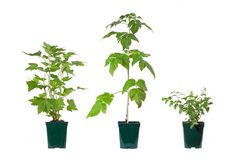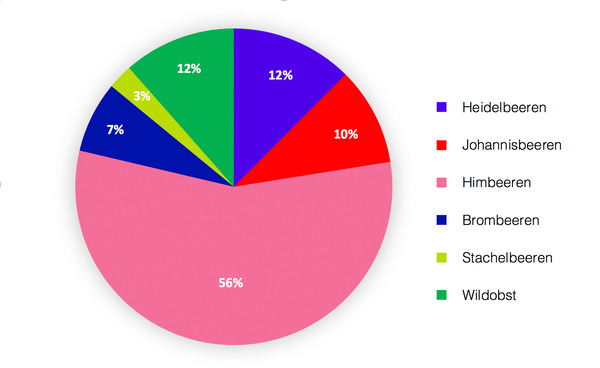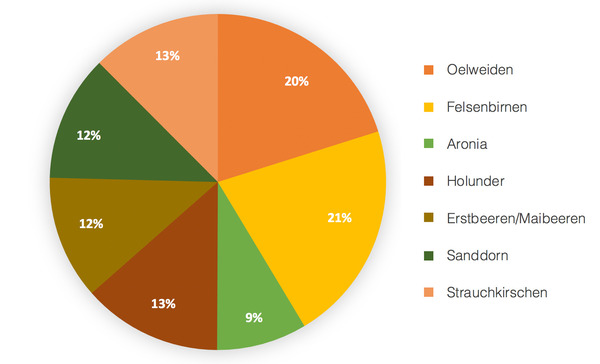 Actually, no one really knows the exact demand for berry plants. The market is too small for a statistically analysable survey to be worthwhile. By interpreting the sales figures of our online sister company Lubera.com for this small study, we can gain important insights into the natural demand for berry plants.
Actually, no one really knows the exact demand for berry plants. The market is too small for a statistically analysable survey to be worthwhile. By interpreting the sales figures of our online sister company Lubera.com for this small study, we can gain important insights into the natural demand for berry plants.
Natural demand – what is that?
The term 'natural demand' is a bit deceiving; you immediately ask yourself what unnatural demand would be...With the term we only want to point out that very many sales figures in this plant niche area do not reflect demand, but are simply driven by supply. If a DIY chain sets up a pot plant trolley with mixed berry plants twice a year, the sales figures will in the end reflect exactly this supply; at best one can draw some conclusions about the reaction of the public with regard to the speed of sales and the remaining items.
Natural demand means what consumers in a large geographical area (DACH region) demand for berry plants over a period of 12 months.
The origin of the figures on natural demand for berry plants
As in previous similar studies, we access the figures of our sister company Lubera.com, which sells plants online in the DACH region. The exciting and meaningful thing about this is that the supply is very broad (very many species and varieties) and also very constant throughout the year. One could also argue somewhat maliciously, but quite accurately, that the supply at Lubera.com almost always slightly exceeds the demand – precisely for this reason one can gain a good picture of the natural demand here. Of course, there are also individual promotions, but these affect almost all types of fruit throughout the year. Now, of course, one could argue that buying from a specialist like Lubera would be very different from buying from a plant centre, for example. But Lubera.com offers fruit and berries in the midst of a general plant assortment with more than 6000 articles, which means that it is not just the fruit nerds who are out and about here. In addition, the figures are also easy to analyse because it is not just a matter of a few random plant purchases; over the year Lubera.com receives more than 150,000 orders.
The distribution of berry plants sold by species
If you add up the total berry sales (always the number of plants) over a period of 12 months and calculate the percentage distribution of sales, the following picture emerges:

Graphics: Breakdown of sales according to berry types
In the case of currants, we have included the jostaberries. By wild fruit we understand shrub-like growing plants with berry-like fruits, which as a rule have been cultivated only a little and which also occur less frequently in the garden, often only since a few decades. We have counted the following fruit species as wild fruit: oleaster (especially our Pointilla® varieties), serviceberry (especially the Saskatoon varieties), chokeberry, elderberry, honeyberries/Firstberries®/mayberries, sea buckthorn and bush cherries, which we do indeed offer bushy and are to be grown as shrubs (not as trees).
The absolute bestseller: raspberries
At first glance, you can see one of the special features (perhaps also one of the problems) of the berry category: the absolute dominance of raspberries. If you add the other caneberries (meaning blackberries and raspberries), they comprise well over half of the demand. Not only is the cultivation of raspberries and blackberries with the biennial cycle of above-ground shoots quite different from the woody, small shrubs of the other berries, they are also usually not planted alone or in pairs, but there are already three to ten plants in a raspberry row. Considering this purchasing pattern and the absolute quantity of raspberries, it certainly makes sense to offer raspberries and blackberries rather in smaller pots (12 cm, 1 L, 2 L), but the typical offer on a pot plant trolley with all other berries and also some other fruits like figs, kiwi etc. has to be questioned.
Each reader must of course draw their own conclusions here for their production, for their buyers and their customers, but with raspberries and blackberries it is certainly worthwhile to have a continuous supply structure. It would probably also make more sense to have a pot plant trolley or special offer with only raspberries or otherwise together with a fruit type that is also very frequently bought, such as strawberries, than the 'all in one' trolley.
Blueberries are in second place
It is probably no surprise to all readers to see blueberries in a safe second place, about 20% above currants. The rise of blueberries seems unstoppable. Nevertheless, a few things catch my eye:
- It feels like blueberries are offered – and probably sold – in pot plant trolley offers far out of proportion to these numbers. After all, they look beautiful almost all year round. After the blossom come the fruits, then the red autumn colours and in winter the green to red shoots...
- We also notice at Lubera.com that promotions or weekend deals with blueberries usually sell twice as well as similar offers with currants. The reason could be that the permanent supply of blueberries in the supermarket triggers more demand for bushes. There's nothing to be said against that...
- But does it also work in the garden what apparently works so smoothly in the shops? No one would have me believe that the majority of blueberries bought from a mixed berry pot plant trolley are actually planted in a functioning bog bed. The foreseeable ban on peat will make this even more difficult. Of course, one can take the position that the sale works, but the category of berry plants and thus the entire market is not really served by a product that fails en masse in the garden. It's just as well that most hobby gardeners look for the fault in themselves (yes, that's where it lies...) and after 12 or 24 months of blueberry exposure in the supermarkets, they soon decide to buy the next plant again: let's try it again! How long can this go on?
Would there be alternatives to establish the sweet, fat, blue fruits in the garden in a more sustainable way? I will limit myself here to a few ideas with key words:
- Differentiating the range and also the pot plant trolley mixes with large and small plants, plus other bog plants such as cranberries
- Separate blueberry plant trolleys and offers make it easier to inform the customer at the POS
- Would a mix with bog plants be possible?
- Promoting blueberries as the ideal berry plant for pots
Attention: do not neglect currants
A surprise for me was the good performance of the currants (red, pink, white, black). With the wide range on offer and especially with new large-fruited varieties such as ‘Black Marble’ (1.5-2 cm in diameter), which can also be snacked on individually like blueberries and which are very sweet and aromatic, a new market can be opened up for currants. When we take friends, acquaintances or even a group of visitors to the nursery and let them eat new blackcurrants or the red currant Ribest® Lisette® with its large fruits, we only hear surprised praise. When I look at current mixes on pot plant trolleys, currants are usually rather underrepresented, about only half of the blueberry plants, and I wonder if the demand is very close to the blueberries...
One more thing: with all true bush berries (perennial woody shrubs), in contrast to raspberries, single or only a few plants are planted. This increases the willingness to pay per plant. There is also a significant difference in yield and yield onset whether I buy a one-year-old currant in a 1 L pot or a shrub in a 4 L or 5 L pot. The latter will immediately bear a lot of fruit, while the former will have to wait a few more years – provided that the small plant is successful against the weeds.😉 I would therefore advise selling plants of a higher quality.
Gooseberries – a fruit species on the decline
The market share of gooseberries is declining and declining. This can also be seen in person: when our son Lukas proudly led some friends from far away from the industry through our crops this summer and gave them his favourite berry, precisely the gooseberry, to try, none of the friends who had grown up in the countryside had ever eaten a gooseberry...
What are the problems with gooseberries?
The resistance to American gooseberry mildew, which should be absolute, as it is with the newer blackcurrants; thorns, especially in the large-fruited varieties (the varieties with few thorns are usually smaller); then recently also the climate, with an open and rich-bearing gooseberry bush there are currently often sunburn symptoms in midsummer, in June. Future-proof gooseberries would therefore have to be resistant, thornless, large-fruited and dense. Can breeding succeed with gooseberries, where we in Western Europe are currently working almost alone on this type of fruit? But new, better varieties are the only way to preserve a market for gooseberries and for us, which would already be attractive: the gooseberry is and remains by far the largest single fruit among the berries (if we disregard the giant strawberries) and has the potential to fill the entire mouth and to activate all taste receptors in a sweet-sour-juicy way.
The surprise result: wild fruit bushes
Wild fruit bushes are the surprise in this bird's eye view of berry demand: we sell almost as many wild fruit bushes and wild berry bushes as currants at Lubera.com. The fact that we have included oleasters (Pointillas®), serviceberries, chokeberries, elderberries, honeyberries/Firstberries®, sea buckthorn and bush cherries in this is quite comparable to the situation with currants, since black, white, pink and red currants are also included here.
Why the relative success of the wild fruit bush category: apparently, the health potential, but also the informal character of the near-natural, simple cultivation seem to fit well with the customer mindset: you can harvest wild fruit bushes, but you don't have to if you don't have the time. Many wild fruit bushes also have an ornamental value. Especially if you put together real bush berry assortments (without raspberries and blackberries) and if you choose somewhat more valuable pot sizes, a wild fruit mix is a must.
Here is a brief insight into the breakdown of wild fruit bushes by species:

Graphics: Breakdown of wild fruit sales by species
The best-selling species by far, each on par with gooseberries, are Elaeagnus (the early and late Pointillas®) and Amelanchier (serviceberries/Saskatoon berries). This may have to do with the fact that we offer our own varieties of both, but we (Lubera Edibles and Lubera.com) do the same with all bush berries. With their high ornamental value and the health-promoting ingredients of their directly edible berries, oleasters and serviceberries obviously have a much greater potential than other wild fruit species such as elderberries, sea buckthorn and also Firstberries®.
